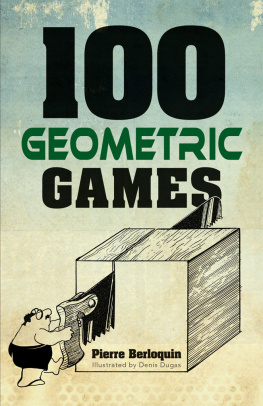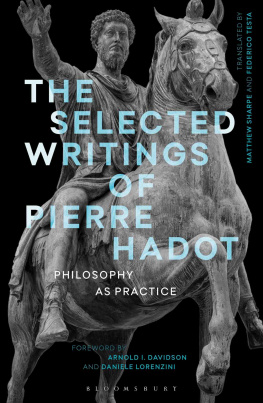Pierre Berloquin - Hidden Codes & Grand Designs
Here you can read online Pierre Berloquin - Hidden Codes & Grand Designs full text of the book (entire story) in english for free. Download pdf and epub, get meaning, cover and reviews about this ebook. year: 2010, publisher: Sterling, genre: Home and family. Description of the work, (preface) as well as reviews are available. Best literature library LitArk.com created for fans of good reading and offers a wide selection of genres:
Romance novel
Science fiction
Adventure
Detective
Science
History
Home and family
Prose
Art
Politics
Computer
Non-fiction
Religion
Business
Children
Humor
Choose a favorite category and find really read worthwhile books. Enjoy immersion in the world of imagination, feel the emotions of the characters or learn something new for yourself, make an fascinating discovery.

- Book:Hidden Codes & Grand Designs
- Author:
- Publisher:Sterling
- Genre:
- Year:2010
- Rating:5 / 5
- Favourites:Add to favourites
- Your mark:
- 100
- 1
- 2
- 3
- 4
- 5
Hidden Codes & Grand Designs: summary, description and annotation
We offer to read an annotation, description, summary or preface (depends on what the author of the book "Hidden Codes & Grand Designs" wrote himself). If you haven't found the necessary information about the book — write in the comments, we will try to find it.
Hidden Codes & Grand Designs — read online for free the complete book (whole text) full work
Below is the text of the book, divided by pages. System saving the place of the last page read, allows you to conveniently read the book "Hidden Codes & Grand Designs" online for free, without having to search again every time where you left off. Put a bookmark, and you can go to the page where you finished reading at any time.
Font size:
Interval:
Bookmark:
HIDDEN
CODES &
GRAND
DESIGNS
CODES &
GRAND
DESIGNS
Secret Languages from Ancient Times to Modern Day
Pierre Berloquin

For my dear wife, Marie-Thrse
STERLING and the distinctive Sterling logo are registered trademarks of Sterling Publishing Co., Inc.
Library of Congress Cataloging-in-Publication Data Available
10 9 8 7 6 5 4 3 2 1
Published by Sterling Publishing Co., Inc.
387 Park Avenue South, New York, NY 10016
2008 by Pierre Berloquin
Distributed in Canada by Sterling Publishing
c/o Canadian Manda Group, 165 Dufferin Street
Toronto, Ontario, Canada M6K 3H6
Distributed in the United Kingdom by GMC Distribution Services
Castle Place, 166 High Street, Lewes, East Sussex, England BN7 1XU
Distributed in Australia by Capricorn Link (Australia) Pty. Ltd.
P.O. Box 704, Windsor, NSW 2756, Australia
Manufactured in the United States of America
All rights reserved
Sterling ISBN 978-1-4027-2833-4
For information about custom editions, special sales, premium and
corporate purchases, please contact Sterling Special Sales
Department at 800-805-5489 or specialsales@sterlingpublishing.com.
CHAPTER 1
The Dawn of Code
CHAPTER 2
Pythagorass Codes
CHAPTER 3
The Knights Templar
CHAPTER 4
The Vitruvian Saga
CHAPTER 5
Freemasons from Guilt to Free
CHAPTER 6
Homophones and Vigenre
CHAPTER 7
Washington 108
CHAPTER 8
Turing Turing
CHAPTER 9
Migrating to Code Land
CHAPTER 10
The Cipher Gallery
Writing about hidden codes is a paradox. Secret activities traditionally are concealed behind codes and ciphers. However, time passes. Secrets eventually float up from the dark waters of occult groups and mystical communities. However secret their activities are, people love to leave traces behind. They hope to survive through their actions and creations. They want to keep their actions secret, but their grand designs have to be public so that they can amaze the universe.
We humble curious historians can only stand outside their secret worlds and gaze at their achievements or explore whatever archives reach us. In that sense, their code is both their most intimate and most vulnerable secret. It can be the code of their secret ciphered exchanges or the aesthetic code of their achievements. Breaking and entering their codes leads us to knowledge of their daily arcane life as well as to understanding of their great achievements.
We now live in codes. The world we have developed and live in is more coded every day.
We use codes to open and close our houses, cars, computers, cell phones, e-mails, and bank accounts. These codes are strangely similar, not to say identical, to the magic formulas of fairy tales, in which wealth and life depended on the knowledge of one word. An open sesame would open caverns or stop armies. Today, digital keyboards everywhere await our codes, and amulets we call credit cards generate money from ATMs. We live in a fantasy writers dream. No wonder fantasy books and films are so successfulthey depict our daily lives.
Coding becomes a virtual extension of our skin, defining what we are and what we are not: I code, therefore I am.
All this magic relies on computers to manage the business of delivering, remembering, and checking codes. Computers work from programs, which are codes, the critical links between human thought and nonhuman machinery. Codes within codes within codes, as formerly there were wheels within wheels, but the watchmakers world has given way to the more subtle programmers world. Subtle or complex? Should we fear the day when one more code will gridlock the whole system or the day when codes carry on their business without caring about us?
With codes managing security, we dont have to carry physical keys anymore. We carry codes in our heads. Is that how society protects itself against the insane? Lose your mind, lose your memory, and you are shut out of your house, your car, and the rest of your life. Remember your codes and you are back in your world. Or is that how we progressively give the keys of our universe to memoryproof, absolutely logical machines that will never fail to remember the codes?
As youll see in , Pythagorass Codes, that must be how an ancient Greek named Pythagoras felt before the universe two and a half millennia ago. He intended to break the codes of nature. Knowing the codes, he could become a player instead of a bystander indefinitely played by the world. The pentagram, the right angle, and perfect numbers were Pythagorass mystical set of keys. With those keys, he could start creating, assured that his creations would be as valid and beautiful as the original creation. Ever since Pythagoras, mystical societies have revered Pythagorean codes and strived to transmit them. Architects, builders, and artists have lived by his codes to guarantee the aesthetic value of their works.
This book explores how codesboth cipher and aesthetichave come to exist and develop parallel to common open writing and speech. Coding is probably as old as humanity. We follow the developments of code from the ancient world of Pythagoras and Aeneas the tactician (, The Dawn of Code) to the present.
Code is a rich and ambiguous word. It can be a reference: a moral code, an aesthetic code, a code of honor, or a dress code. It also can be the key to a cipher in which one purposely hides a meaning that someone else can read by using the same code. This means it can be a key to being true to your surroundings or a key to treacherous diplomacies aimed at your brothers. We follow these two threads throughout the book because they cannot be separated.
Codes have been a concern of pure mathematicians such as Pythagoras (600 B.C.E.) and Alan Turing (1940), who believed in being true to ones surrounding but who also had to take part in wars.
Ciphers are fascinating subjects because cipher making and cipher breaking are like puzzles applied to real life. The contest between the cipher maker and the cipher breaker is the ideal contest between two minds. Coders and codebreakers keep outwitting one another. It may be roundly asserted that human ingenuity cannot concoct a cipher that human ingenuity cannot resolve, Edgar Allan Poe wrote in 1840. Indeed, the history of cipher has proved that no secret writing resists breaking forever. Some codes have taken several centuries to break into, but eventually all of them were broken. We see in , Homophones and Vigenre, that the Vigenre method was renowned for three centuries as an absolutely unbreakable cipher, only to be broken by a simple solution.
Although it looks like a puzzle, it is important to stress that a cipher is not a puzzle. What is the difference? A real cipher is a conversation. It involves three persons: the sender, the receiver, and the breaker. The sender writes a text, turns it into a ciphertext with a code, and sends it to the receiver. The ciphertext is supposed to be unreadable by the breaker. Later, the receiver, knowing the code, is able to get back to the original clear text. However, this is not happening in the virtual world of games and puzzles; it is happening in real life, and that has two consequences. First, the coding method has to be practical and as foolproof as possible: the coder needs be sure that the receiver will read the message easily and correctly under stress and in difficult conditions such as a combat environment or a diplomatic mission in a hostile country. Also, the sender and the receiver know that the codebreakers success or failure is a matter of time: time, ingenuity, or plain intelligence information will bring clues and crack the code wide open. A cipher can always be made harder to break by coding and recoding a message several times, as one would put a safe in a safe in a safe, but chances are that it will become unbreakable for its very users. The risks of error will be high, not to mention the time lost in coding and uncoding. A simple mistake in one of the steps will render the code useless.
Next pageFont size:
Interval:
Bookmark:
Similar books «Hidden Codes & Grand Designs»
Look at similar books to Hidden Codes & Grand Designs. We have selected literature similar in name and meaning in the hope of providing readers with more options to find new, interesting, not yet read works.
Discussion, reviews of the book Hidden Codes & Grand Designs and just readers' own opinions. Leave your comments, write what you think about the work, its meaning or the main characters. Specify what exactly you liked and what you didn't like, and why you think so.







